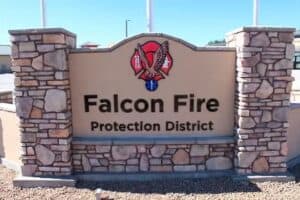The Falcon Fire Protection District held its regular monthly board meeting May 17. All board members were present, along with Richard Shearer, legal counsel for the district.Falcon firefighter Cody Finn-Kuecker was sworn in as a lieutenant.Treasurerís reportFire Chief Trent Harwig reported that 33 percent of the fiscal year was complete. Forty-seven percent of anticipated revenues has been received, and general fund expenditures were at 26 percent.Incident statisticsThere were 193 calls for service in April ó 40 more than April 2016. The year-to-date total is 713 incidents, which represents a 2.3 percent increase over the same period in 2016.Preliminary statistics indicate that the new Station 4 is already reducing response times to District 4, which includes areas in the vicinity of Constitution Avenue and Marksheffel Road. In 2016, FFPD response times to District 4 averaged 11 minutes and four seconds. Between May 12 and May 17, the average response time was four minutes and 44 seconds. The data analyst cautioned that this is an early snapshot but it demonstrates improved service to that area.Meridian and U.S. Highway 24 intersectionDirector Tom Kerby said issues with right-of-way, design layout and property owner concerns have slowed the process, but final design plans are close to being completed. He has requested a copy of the final plan to review.Station 4Harwig reported that Station 4 is now in service, and thanked everyone who came out to the grand opening.Gallagher amendmentHarwig said the state approved a residential property assessment rate of 7.2 percent. An informal poll of FFPD members who live in the fire district indicated assessed value increases, ranging from 4.5 percent to around 14 or 15 percent.He said the district projects a 10 percent increase on residential property values but a 10 percent decrease in revenue due to the reduced assessment rate, with new growth estimated at 3 to 4 percent. ìEven with the Gallagher adjustment, we may still see a slight increase (in revenue), but not nearly what was anticipated,î he said. ìWeíll see what happens in the future.îHarwig noted that the residential assessment rate stayed at 7.96 percent for a long time. ìThe best we can hope for is it will stay at 7.2 percent for a long time.îImpact feesHarwig reported that the county held a second work session regarding impact fees being collected by fire districts. He explained that fire districts can conduct studies to determine the appropriate impact fees to support the demands of new growth, but state statute requires that the county enter into an intergovernmental agreement with those districts to allow the fire districts to collect the fees.Harwig said the Hanover, Security and Tri-Lakes Monument fire protection districts have already had impact fee studies done. He said the Housing and Building Association of Colorado Springs supports impact fees for fire districts as long as the statute is being met. Harwig said the county commissioners will probably vote on the IGA at their May 30 meeting.BBC Research & Consulting presentationMollie Fitzpatrick and Clinton Saloga from BBC Research & Consulting explained different methods for establishing impact fees. BBC conducted the impact fee studies for the Hanover, Security and Tri-Lakes Monument fire protection districts. They also presented the information to the El Paso County Board of County Commissioners.ìWe feel good about the county moving forward,î Fitzpatrick said. ìThe commissioners are on board, itís just a matter of getting them comfortable with it.îFitzpatrick said the state statute made it ìexplicitlyî legal for fire districts to collect impact fees, which shift some of the costs of growth to the developments responsible for that growth. Harwig clarified that the El Paso County IGA states impact fees will be collected at the time the building permit application is submitted, regardless of how long an area has been platted.Fitzpatrick described impact fees as one-time use fees applied to new development. She said their expenditure is restricted to infrastructure expansion purposes such as capital projects and physical assets, and must be directly related to service for the new developments. Impact fees cannot be used to fix deficiencies in existing services or for staffing.She said a U.S. Supreme Court case determined that impact fees may be used to improve existing facilities if that work also improves service due to new growth. For example, they cannot be used to remodel an existing fire station, but if the department requires an additional fire truck to service a new development, then impact fees could be spent on adding a truck bay to the existing facility to house the new apparatus.Fitzpatrick said a districtís impact fee fund must be maintained separate from its general fund. Fee amounts may be updated annually based on established inflation indices such as the Consumer Price Index, and may be modified periodically as dictated by significant changes in infrastructure or service population.BBC charges about $10,000 for an impact fee study. It is an 8 to 10 week process that includes all study calculations, preparing the report and presenting the information to the board and/or the board of county commissioners if requested. Fitzpatrick noted that impact fees can be used to pay for the study.Harwig estimated the fire district is losing more than $30,000 per month based on 40 new residential permits per day in the FFPD jurisdiction, and using the Tri-Lakes Monument FPD impact fee model of $777 per new home.The board voted to prepare a contract with BBC Research & Consulting for an impact fee study subject to the county adopting the IGA on May 30. The contract will not go into effect unless that approval happens.




